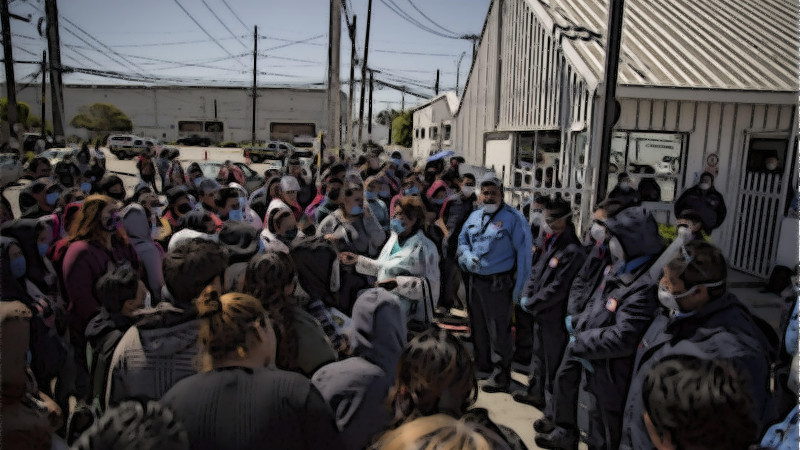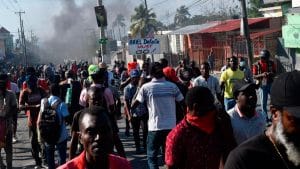Still shots of capitalist barbarism in Mexico, drawn in thick strokes in a newspaper article.
April 14: Of the 16 dead already in Chihuahua, 13 were at a single company: Lear. The workers report that the contagion began with the arrival of a German bosses’ delegation, which toured the facilities without protection.
May 16: Family members and co-workers reported that Juan Antonio Fraire Rodriguez, a worker at FoxConn Santa Teresa in Ciudad Juarez, collapsed while working, killed by Covid-19 and the company’s greed. Days before, he had gone to the company infirmary, where he was given some pills and sent back to his post.
Such photographs, only with different people, can be found from throughout the maquiladoras in the border cities. Behind those factories stands the inhospitable desert, cut by a border across which millions of dollars in goods are transported. It is a paradise for capitalist exploitation or a living hell for the precarious labor, depending on the class perspective.
The Situation in the Maquiladoras Today
The U.S.–Mexico border snakes for 3,000 kilometers. It ripples from the Pacific Ocean until it descends into the Gulf of Mexico. Cross-border trade circulates through a wide network of companies on both sides of the Rio Grande and beyond, rendering the manufacturing facilities of both countries inseparable.
Mexico’s maquiladoras export industry employs 3 million workers nationwide in 6,400 companies. In the six border states alone — Baja California, Sonora, Chihuahua, Coahuila, Nuevo Leon, and Tamaulipas — there are 1.8 million workers at 3,700 companies, many of which are transnational. The maquiladoras produce everything from electronics, textiles, and automotive parts to components for the U.S. war industry. The border is crisscrossed by proletarian cities that for years have put the lie to any notion that a working class no longer exists. The working class may be hidden by the organic intellectuals of the bourgeoisie and their paid pens in the media, but it is clearly present in the urban geography and in the profits of the exploiters.
The origins of the maquiladoras date back to the mid-1960s, driven by Mexico’s Border Industrialization Program and the easing of customs tariffs.1Translator’s note: Beginning in 1965, the Mexican government’s Programa de Industrializacíon Fronteriza lowered tariffs and duties on machinery, equipment, and raw materials and allowed foreign firms to use factories that had been built under a national infrastructure development program to manufacture and export goods at much lower costs than in many countries. In 1985, the system began to take off. When the North American Free Trade Agreement (NAFTA) was inaugurated on January 1, 1994, the first network of companies installed on the northern border already existed. From then until 2000 saw the greatest expansion. By the beginning of the new millennium, manufacturing exports had increased six-fold from the levels of 15 years earlier, with maquiladoras accounting for 49 percent of the total.
In the NAFTA context, the country became a platform for manufacturing exports oriented primarily to the United States, which accounts for 80 percent of Mexico’s balance of trade. All this benefited transnational and foreign companies, which took advantage of a cheaper labor force, the proximity to the border, and tax breaks offered by the governments, as well as trade unions that for decades had allowed capitalist abuses. At the same time, Mexico’s participation in one of the world’s most important value chains, the automotive industry, increased.
The maquiladoras industry has, for decades, been at the center of the economic scheme that is the “trademark” of neoliberalism in Mexico. Highly subordinated to the interests of imperialism and U.S. capital, it has not been challenged by the “progressive” government of Andrés Manuel Lopez Obrador.
As one article argues, the maquiladoras underwent a process of transformation over several decades, increasingly incorporating technological and organizational changes and extending beyond the six border states to have a presence in 24 of Mexico’s 32 states.
What has not changed, though, is that the maquiladoras “magic” lies in the sweat and overexploitation of the labor force. Its persistence, despite the various economic crises over time, can be explained by the low wages — lower not only than in the United States but even lower than in China. It is, in short, the greatest extortion of surplus value from the Mexican working class, which feeds the coffers of business and the transnationals.
As another article puts it, rather harshly:
Death is sometimes slow in the maquila, but it always has permission — as in the stitching and strap factories that eat away at the shoulder, wrist, hip, and knee joints of the workers because of the accelerated and repetitive pace of work that always expects greater productivity and, with that, the health of those who generate wealth in exchange for starvation wages. … Let’s not forget the cases of workers at Foxconn — and so many other maquilas — who have been poisoned, or those at Lexmark who have fallen ill from the respiratory illnesses and the many others who have died because of the toner accumulated in their lungs.
This corporate greed was aided by a militarization that imposed terrible conditions for the workers and people on the border — a trail of dead and missing people that turned the stuff of fiction into reality. And at the same time, the femicide — that aberrant phenomenon that is part of capitalism’s decomposition — hit the maquiladoras in particular. The desert crossings bear testament to that, and stand as a reminder of the victims of femicide violence.
Nevertheless, against all odds, and despite the capitalists, the politicians who serve them, and the collaborationist trade union leaderships, workers’ resistance finally emerged in the north of the country — the same north where, more than 100 years ago, a part of Insurgent Mexico burst forth.2Translator’s note: The “Insurgent Mexico” reference uses the title of a book by John Reed about the uprising led by Pancho Villa in northern Mexico in the early part of the 20th century.
Where the Heart of Workers’ Resistance Beats
There is no question that the maquiladoras export industry is the nerve center of Mexican capitalism. In the last five years, we have experienced three waves of protest by its hidden and suppressed proletariat.
Since mid-2015, and during the harsh winter that marked the beginning of 2016, it was the workers of Ciudad Juarez, Chihuahua, who said enough is enough. A movement that emerged in several companies — Eaton’s Bussmann Division, Scientific Atlanta, CommScope, and Lexmark — converged and demanded the reinstatement of fired workers, the right to free unionization, and wage increases. The independent candidacy of Antonia Hinojos (“Toñita”) — a maquiladora worker who was an activist in all this — emerged from the movement.3Translator’s note: Antonia Hinojos Hernandez announced her candidacy for mayor of Ciudad Juarez in early 2016, but was kept off the ballot after failing to collect the high number of signatures required by undemocratic election laws. It was an unprecedented event in national and state politics.
The second milestone was the 20/32 Movement in Matamoros, Tamaulipas. It was driven by the demand for a 20 percent wage increase and an annual bonus of 32,000 pesos, and it encouraged a rejection of the trade union leaderships that had once again turned their backs on the workers to make agreements with the bosses. What emerged was a historic movement that covered 90 industrial plants and 90,000 striking workers. In the context of the severe blow from the layoffs of many activists, support grew for a new union (the National Independent Union of Industries and Services 20/32) and several local independent workers’ candidacies emerged.
The third wave was a response to the criminal policy of the employers. In the main border cities, 50, 60, and even 80 percent of companies were still working from the very beginning of the coronavirus pandemic, while the government and the Secretary of Labor and Social Welfare took no measures to guarantee the closure of the factories beyond lukewarm “words of caution” and “recommendations.” The hundreds of complaints we heard at La Izquierda Diario, which turned into thousands on social media, revealed the terrible working conditions and non-existent safety and hygiene measures for workers. There was a lack of antibacterial gels, soap, and drinking water, and pregnant women and older workers were forced to stay on the job. In violation of all labor rights, those who requested leaves were laid off and had their wages cut.
Due to all this, the maquiladoras became a center of infection. The result was a story of death: as of May 20, 432 workers had died in Baja California, while in Ciudad Juarez, there were already 104. Obviously, if we account for the rest of the industrial plants on the border, the number of deaths among the working class in the north will painfully exceed three figures.
Against this difficult backdrop, the month of April saw a wave of strikes and walkouts, actions not unlike actual riots, in dozens of maquiladora companies along the serpentine border. As discussed in this article, there were protests at, among others: Creation Technologies, Clover Wireless, Honeywell, Plantronics and Skyworks (Mexicali); Tridonex, Autoliv, VDO, NovaLink (Matamoros); and Legrand and Hyundai (Tijuana). The slogan “We want to live!” showed that the working class, faced with the desolate landscape to which capitalist exploitation was leading them, demanded its most elementary right: the right to live.
This resistance that has emerged in recent years has brought to the fore sections of the industrial proletariat that had been absent. These processes were undoubtedly tortuous, and in many cases the workers did not achieve all their demands. They faced attacks from the bosses, governments, and trade union leaders who sought to isolate them and repress the new workers’ activism. That pointed the way for higher moments of class struggle to emerge.
Criminal Negligence Amidst Unemployment and Precariousness
On Monday, May 18, by order of President Lopez Obrador, the reopening of the maquiladora and automotive industries, now considered “essential,” began. Washington, the transnationals, and the business leaders got what they wanted: an industrial reopening that would feed the value chains that cross the border and U.S. industry. The urgency is evidently driven by the upcoming implementation of the new U.S.–Mexico–Canada Agreement on trade. This shows the extreme subordination of the “progressive” Mexican government to Trump, against the health and lives of the working class.
The presidential declaration legitimized the maquiladora companies that were already operating and reopened the rest, as well as the automotive manufacturers. This measure comes just as the number of positive cases and deaths from the coronavirus is rising; as of this writing, there have been close to 10,000 deaths officially. It is an act of negligence that only worsens the bleak panorama of worker deaths, genuine industrial homicides that have been reported at Clover, Lear, and elsewhere.
The dynamics the class struggle may yet acquire cannot be considered without accounting for Mexico’s difficult economic and social context. Forecasts of a decline (no less than 7%) in the gross domestic product for this year and the next are combined with an unusual increase in unemployment. Not even the crises of 1995 or 2009 saw such a collapse of the economy. While the government is massaging the official figures, at least 700,000 jobs were lost in the formal sector just in the first two months of the pandemic. In Ciudad Juarez alone, some 150,000 maquiladoras workers are estimated to become newly unemployed. On a national scale, there is talk of 2 to 4 million people who will join what Karl Marx called the “industrial reserve army.” This is in the context of a rising sea of precarious work throughout the country, with wage cuts and the loss of other gains. All this is the result of the business response to the crisis, which, as usual, aims to put it on the backs of the working class and the people.
It wasn’t just the maquiladora workers who stepped forward. Health workers have made their voices heard in various protests. Discontent has grown among the precarious youth working at the call centers and now is being revealed among those who work for the apps. Struggles such as those at Notimex4Translator’s note: In February, workers at Notimex — Mexico’s state news agency — launched a strike over spending cuts. and at the National Autonomous University of Mexico5Translator’s note: Students at the university, known as UNAM, began a strike in early October 2019 against gender violence and sexual assault by professors. are also being waged with great determination. The discontent raises the possibility of a revival of the class struggle, despite the fear of unemployment and taking up again the path opened by the maquiladora proletariat.
Internationalism and Anti-capitalism on the Border
The prospect of precariousness, unemployment, and violation of the most basic labor rights — as demonstrated in the current pandemic crisis — requires an alternative response to that given by the bureaucratic trade union leaderships. The Confederación de Trabajadores de México, which holds title to many of the collective bargaining agreements in the maquiladoras, has played a crucial role in maintaining capitalist stability. The waves of protest referred to above emerged mostly spontaneously and against the bureaucratic leaderships — and they raise the need to reclaim and build trade union organizations for the struggle.
One of the consequences of any crisis is that it disorganizes the workers’ ranks, deepening divisions among them: between the employed and unemployed, between the organized and unorganized, between the most precarious and those who retain some benefits. In the face of this, it is essential to unify the ranks of the workers and make those who caused the crisis pay for it.
In this sense, opposition to wage cuts and layoffs, and the demand that any company that closes or lays off workers be expropriated under the control of its workers, must be accompanied by the distribution of working hours among all hands available, at a wage that meets basic needs and that increases with inflation. The unusual increase in unemployment is already a reality, and it requires a strong response that looks after the interests of the working class.
As Leon Trotsky stated in “Trade Unions and the Social Crisis” (1938):
First of all the trade unions must pose squarely the problem of unemployment and wages. The sliding scale of hours as formulated by you is correct: all must have work. But the sliding scale of hours must be supplemented by a sliding scale of wages. The working class cannot permit a constant lowering of its standard of living, as this would be tantamount to the collapse of human culture. The highest earnings on the eve of the crisis of 1929 should be taken as the point of departure. The powerful productive forces created by the workers did not disappear, did not perish; they exist. Those who own and dispose of the productive forces are responsible for unemployment. The workers know how to work and want to work. The work must be divided among all the workers. The earnings of each worker should not be lower than the maximum reached in the past. This is the natural, the necessary, the inexorable demand of the trade unions. Otherwise they will be crushed aside by historic development as so much trash.
There can be no doubt that Trotsky’s words, even with all the time that has passed, maintain in their essence all their validity in view of the approaching catastrophe.
The history of the labor movement of northern Mexico has pages of heroic struggle marked by internationalist solidarity. In 1906, one of the preludes to the Mexican Revolution was the strike in Cananea against the U.S. employer William Greene and his partners in the Mexican government. The revolutionary American trade unionists of the Industrial Workers of the World (IWW) forged bonds of internationalist solidarity with the workers at Cananea and with the Mexican Liberal Party of the Flores Magón brothers, who were active there. After the defeat of the strike, the Wobblies (as IWW workers were known) actively campaigned for the release of the prisoners. Today, we must reclaim these pages of struggle.
Today, there are many ties between the maquiladora working class and the multiethnic U.S. proletariat — from the existence of millions of Mexican migrants who work in the heart of imperialism to the fact that they are part of the same productive fabric that transcends borders.
The allies of the maquiladora proletariat are — along with the rest of the Mexican workers — the U.S. working class and all the other oppressed, such as immigrants and the Black movement that today rebels with the cry of “Black Lives Matter!” The enemies are in the ruling classes, their parties, and the governments of both countries.
A true alliance, one that overpowers borders and walls, can be built only on the basis of anti-imperialism and internationalism and by reclaiming the best traditions of the past for the present. We must weld an alliance on indestructible foundations: the conviction that we must put an end to this system of exploitation and misery and fight for the future of the great majority of workers and peoples.
First published on May 31 in Spanish in Ideas de Izquierda México.
Translation by Scott Cooper
Notes
| ↑1 | Translator’s note: Beginning in 1965, the Mexican government’s Programa de Industrializacíon Fronteriza lowered tariffs and duties on machinery, equipment, and raw materials and allowed foreign firms to use factories that had been built under a national infrastructure development program to manufacture and export goods at much lower costs than in many countries. |
|---|---|
| ↑2 | Translator’s note: The “Insurgent Mexico” reference uses the title of a book by John Reed about the uprising led by Pancho Villa in northern Mexico in the early part of the 20th century. |
| ↑3 | Translator’s note: Antonia Hinojos Hernandez announced her candidacy for mayor of Ciudad Juarez in early 2016, but was kept off the ballot after failing to collect the high number of signatures required by undemocratic election laws. |
| ↑4 | Translator’s note: In February, workers at Notimex — Mexico’s state news agency — launched a strike over spending cuts. |
| ↑5 | Translator’s note: Students at the university, known as UNAM, began a strike in early October 2019 against gender violence and sexual assault by professors. |











